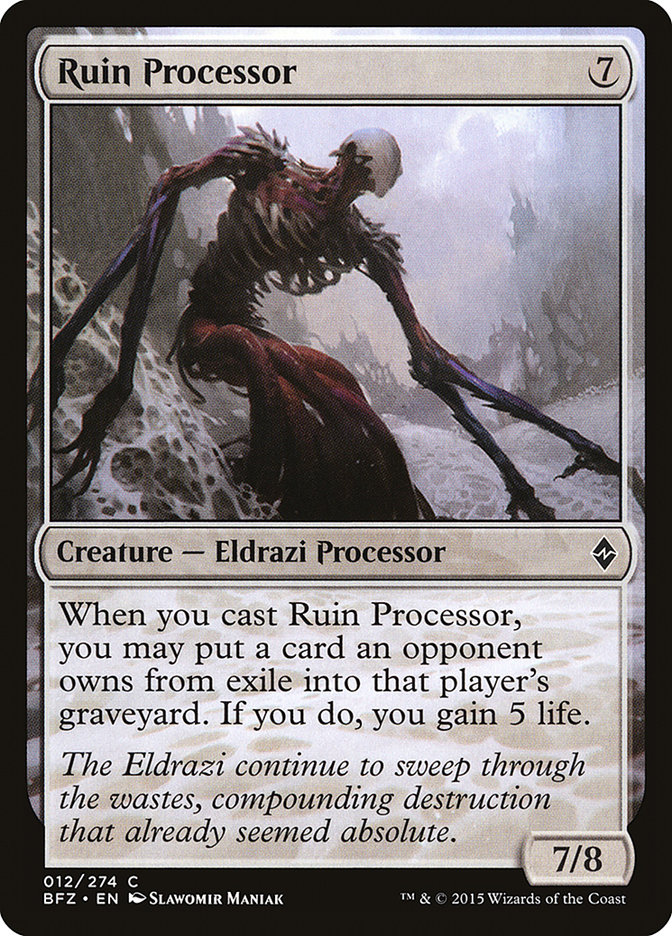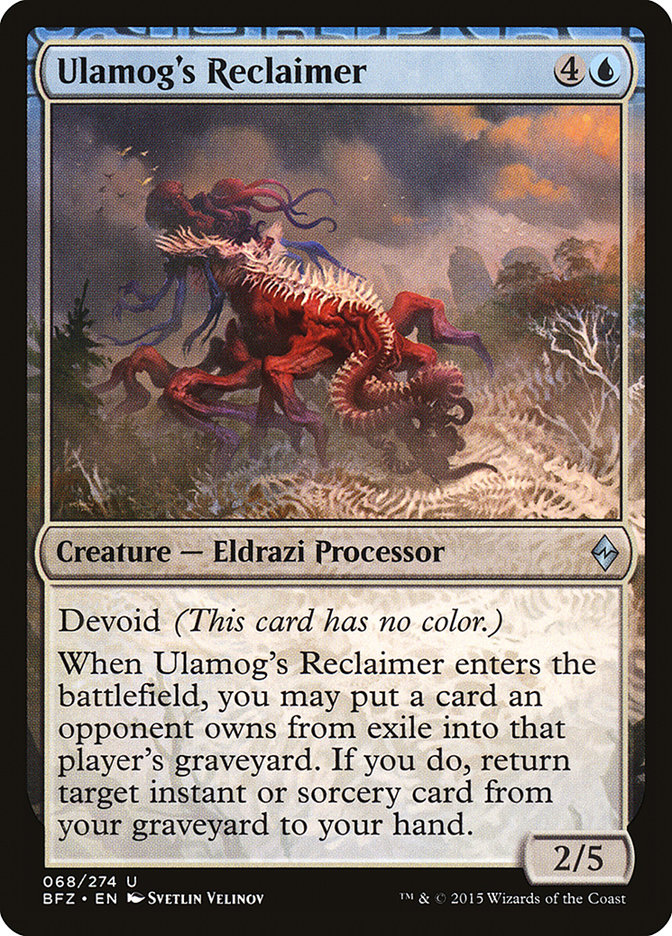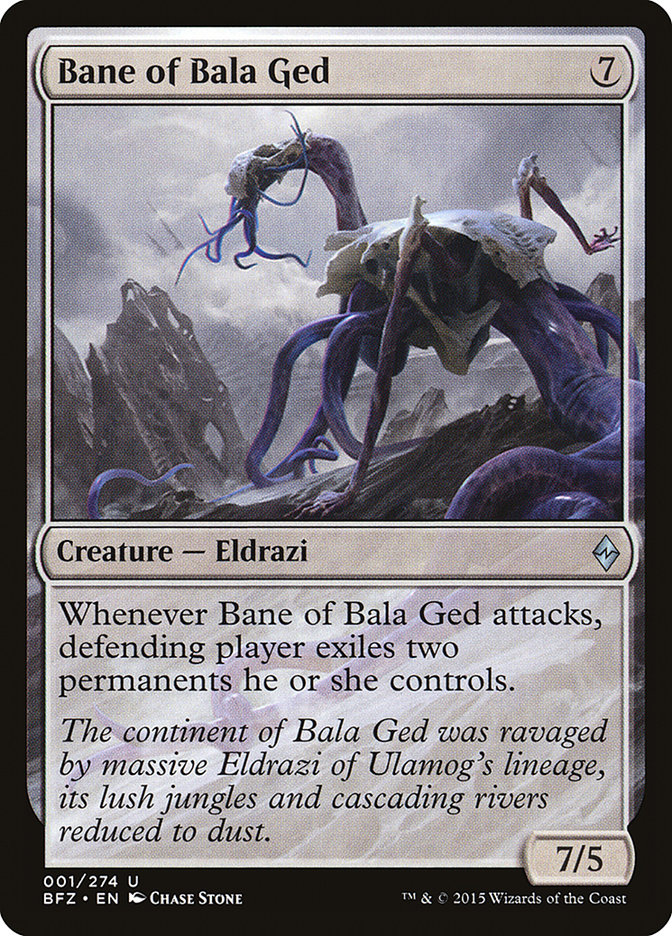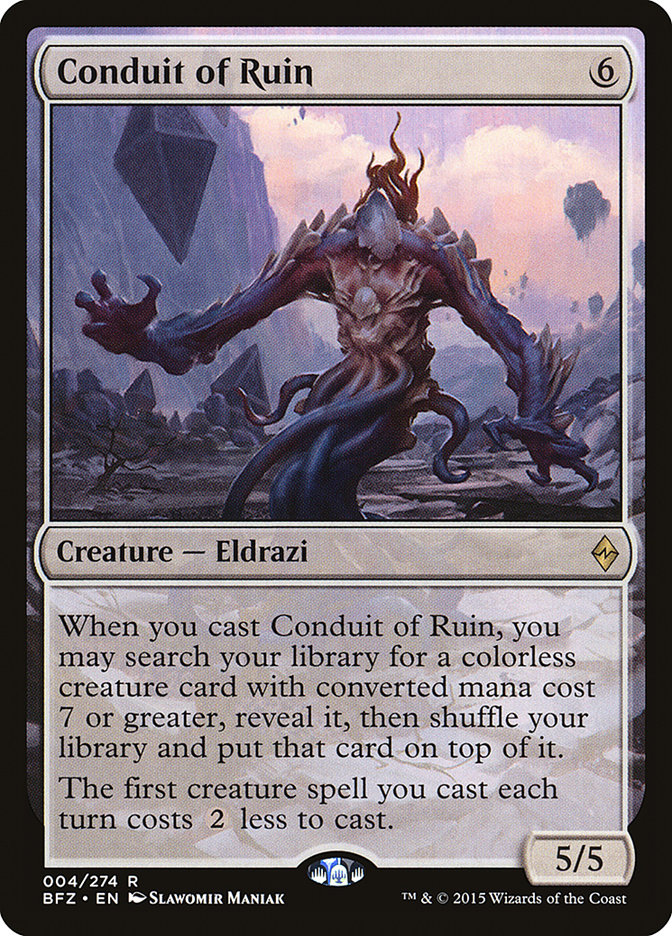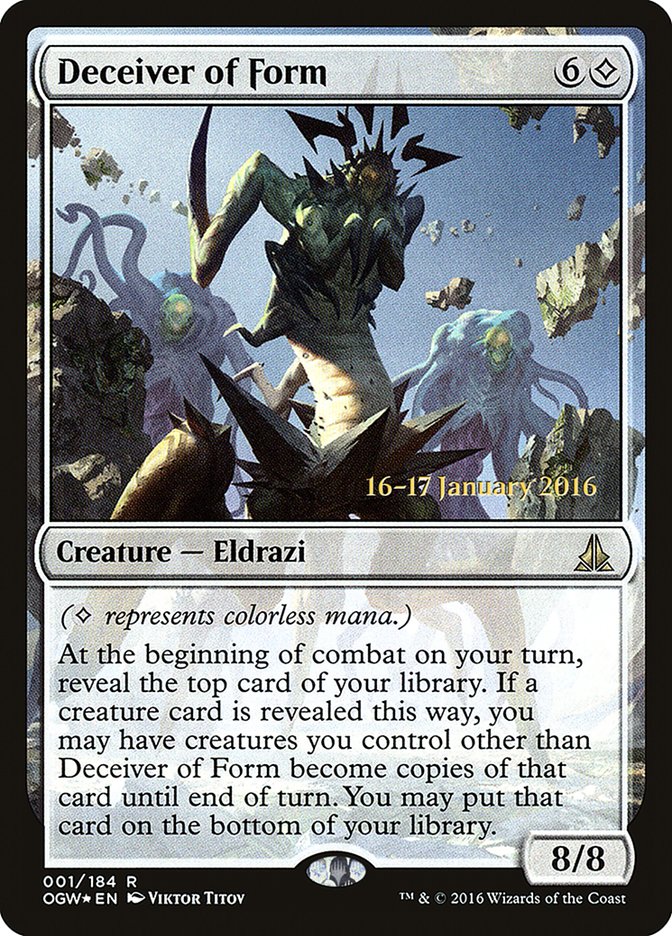Ruin Processor MTG Card
| Mana cost | |
| Converted mana cost | 7 |
| Rarity | Common |
| Type | Creature — Eldrazi Processor |
| Released | 2015-10-02 |
| Set symbol | |
| Set name | Battle for Zendikar |
| Set code | BFZ |
| Power | 7 |
| Toughness | 8 |
| Number | 12 |
| Frame | 2015 |
| Layout | Normal |
| Border | Black |
| Illustred by | Slawomir Maniak |
Key Takeaways
- Ruin Processor’s entrance can pivot the game with a significant life gain, providing stability against aggressive decks.
- The card’s seven mana cost can be restrictive, potentially slowing its integration into your game strategy.
- Flexibility and combo opportunities with life total strategies make Ruin Processor a solid collection addition.
Text of card
When you cast Ruin Processor, you may put a card an opponent owns from exile into that player's graveyard. If you do, you gain 5 life.
The Eldrazi continue to sweep through the wastes, compounding destruction that already seemed absolute.
Card Pros
Card Advantage: Ruin Processor offers a unique opportunity for card advantage in the form of life gain. Notably, when the Ruin Processor enters the battlefield, if you choose to put a card an opponent owns from exile into that player’s graveyard, you gain 5 life. This significant life gain can increase your stability against aggressive strategies, ultimately keeping you in the game longer and offering more chances to draw impactful cards.
Resource Acceleration: While Ruin Processor itself doesn’t directly accelerate resources, its synergy with decks focusing on exiling cards can be a form of indirect resource acceleration. By processing exiled cards, you enable Eldrazi spawn producers or powerful ingest mechanics, effectively opening up avenues to cast more substantial threats sooner than usual.
Instant Speed: Though Ruin Processor is a creature that does not operate at instant speed, it pairs well with cards that do, allowing you to surprise an adversary with life gain and a sizable creature after they’ve committed to their own instant-speed actions. This interaction can shift the momentum of the game providing you with the upper hand in crucial moments.
Card Cons
Discard Requirement: While Ruin Processor offers the potential for health gain, it is contingent upon possessing a card an opponent owns in exile. This dependency can be a setback in matchups where exile manipulation is minimal or inconsistent.
Specific Mana Cost: The casting cost for Ruin Processor is specific and hefty, requiring seven mana, specifically one colorless and six others. This steep cost can inhibit playing the card early in the game or integrating it smoothly into a mana curve.
Comparatively High Mana Cost: With a seven-mana value, Ruin Processor may come too late against faster, more aggressive decks. In a game where tempo can make or break a player’s strategy, the high cost can be a serious disadvantage, and there might be more immediately impactful creatures or spells to cast at a lower mana threshold.
Reasons to Include in Your Collection
Versatility: Ruin Processor offers flexibility in deck construction, easily sliding into ramp and control builds. Its ability to gain life is a significant boon, allowing for a more stable late game against aggressive decks.
Combo Potential: The life gain mechanic of Ruin Processor synergizes seamlessly with archetypes that manipulate life totals for benefits, such as using Aetherflux Reservoir for a decisive blow to the opponent.
Meta-Relevance: Given the presence of graveyard strategies in the current environment, Ruin Processor is not just a sizable creature but also a strategic addition to hinder opponents’ graveyard plans and extend your survival on the board.
How to beat Ruin Processor
Ruin Processor presents itself as a colossal creature in the world of Magic: The Gathering. When this powerful creature enters the battlefield, its ability to gain life for its controller can turn the tides of the game, especially in decks focusing on graveyard manipulation. To effectively combat this behemoth, players need to strategize around the card’s strengths.
Utilizing exile effects can prevent the Ruin Processor from getting value from cards in the opponent’s graveyard. Containment Priest, for example, can stifle creature strategies that revolve around casting from zones other than the hand. On the other hand, graveyard hate cards like Relic of Progenitus can keep graveyards clean and deny the life gain benefit that Ruin Processor offers. Removal spells are also key; a well-timed Path to Exile or Murderous Rider can ensure that the battle is won before the life totals become insurmountable.
Overall, dealing with Ruin Processor requires a proactive approach, managing both the opponent’s graveyard and being ready with removal options. The successful navigation around this formidable adversary speaks to a well-balanced deck and strategic gameplay.
Cards like Ruin Processor
Ruin Processor is a unique creature card that finds its place in the vast universe of Magic: The Gathering. Falling under the Devoid mechanic, its similarity to other processor creatures is striking. It shares a kinship with cards like Ulamog’s Reclaimer, both having the process ability — utilizing exiled cards of your opponent to trigger beneficial effects. Ruin Processor stands out for its ability to gain the player 5 life, a significant amount in any game.
Looking at other comparables, Bane of Bala Ged also employs the Devoid mechanic and presents an alternate form of disruption by exiling two permanents of the opponent whenever it attacks. However, Bane of Bala Ged doesn’t offer the direct life gain that Ruin Processor does, which could be a pivotal advantage. Additionally, Conduit of Ruin deserves a mention. It lacks direct life gain but helps players by reducing the cost of creature spells and assisting in searching one’s library for a creature card to cast next.
The ability to recover a chunk of life with Ruin Processor can be potentially game-changing, especially in matches where maintaining life total is crucial. Its combination of considerable power, toughness, and life-gaining capacity, makes Ruin Processor a valuable addition for players looking to capitalize on ingest and process mechanics.
Cards similar to Ruin Processor by color, type and mana cost
Where to buy
If you're looking to purchase Ruin Processor MTG card by a specific set like Battle for Zendikar, there are several reliable options to consider. One of the primary sources is your local game store, where you can often find booster packs, individual cards, and preconstructed decks from current and some past sets. They often offer the added benefit of a community where you can trade with other players.
For a broader inventory, particularly of older sets, online marketplaces like TCGPlayer, Card Kingdom and Card Market offer extensive selections and allow you to search for cards from specific sets. Larger e-commerce platforms like eBay and Amazon also have listings from various sellers, which can be a good place to look for sealed product and rare finds.
Additionally, Magic’s official site often has a store locator and retailer lists for finding Wizards of the Coast licensed products. Remember to check for authenticity and the condition of the cards when purchasing, especially from individual sellers on larger marketplaces.
Below is a list of some store websites where you can buy the Ruin Processor and other MTG cards:
- eBay
- TCG Player
- Card Kingdom
- Card Market
- Star City Games
- CoolStuffInc
- MTG Mint Card
- Hareruya
- Troll and Toad
- ABU Games
- Card Hoarder Magic Online
- MTGO Traders Magic Online
See MTG Products
Legalities
Magic the Gathering formats where Ruin Processor has restrictions
| Format | Legality |
|---|---|
| Commander | Legal |
| Legacy | Legal |
| Paupercommander | Legal |
| Modern | Legal |
| Oathbreaker | Legal |
| Pauper | Legal |
| Vintage | Legal |
| Duel | Legal |
| Pioneer | Legal |
| Penny | Legal |
Rules and information
The reference guide for Magic: The Gathering Ruin Processor card rulings provides official rulings, any errata issued, as well as a record of all the functional modifications that have occurred.
| Date | Text |
|---|---|
| 2015-08-25 | Face-down cards in exile are grouped using two criteria: what caused them to be exiled face down and when they were exiled face down. If you want to put a face-down card in exile into its owner’s graveyard, you must first choose one of these groups and then choose a card from within that group at random. For example, say an artifact causes your opponent to exile their hand of three cards face down. Then on a later turn, that artifact causes your opponent to exile another two cards face down. If you use Wasteland Strangler to put one of those cards into their graveyard, you would pick the first or second pile and put a card chosen at random from that pile into the graveyard. |
| 2015-08-25 | If a replacement effect will cause cards that would be put into a graveyard from anywhere to be exiled instead (such as the one created by Anafenza, the Foremost), you can still put an exiled card into its opponent’s graveyard. The card becomes a new object and remains in exile. In this situation, you can’t use a single exiled card if required to put more than one exiled card into the graveyard. Conversely, you could use the same card in this situation if two separate spells or abilities each required you to put a single exiled card into its owner’s graveyard. |
| 2015-08-25 | If a spell or ability requires that you put more than one exiled card into the graveyard, you may choose cards owned by different opponents. Each card chosen will be put into its owner’s graveyard. |
| 2015-08-25 | You can’t look at face-down cards in exile unless an effect allows you to. |
